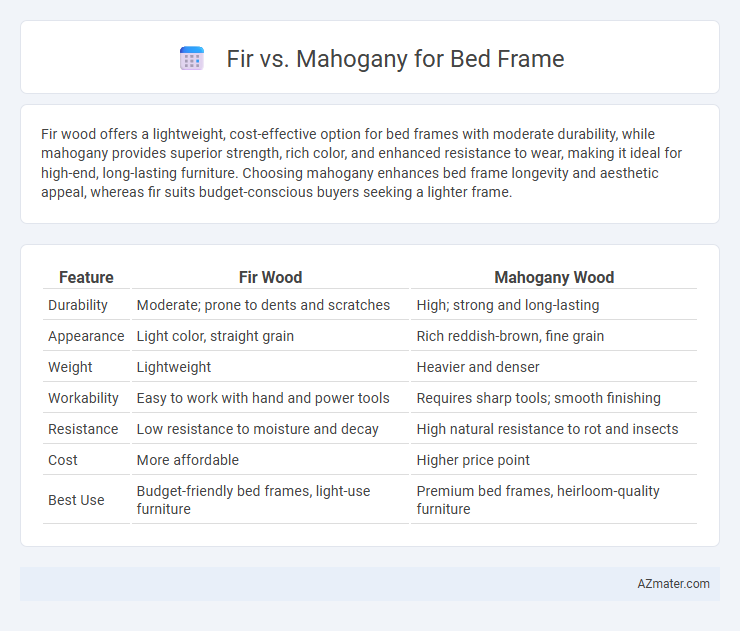Fir wood offers a lightweight, cost-effective option for bed frames with moderate durability, while mahogany provides superior strength, rich color, and enhanced resistance to wear, making it ideal for high-end, long-lasting furniture. Choosing mahogany enhances bed frame longevity and aesthetic appeal, whereas fir suits budget-conscious buyers seeking a lighter frame.
Table of Comparison
| Feature | Fir Wood | Mahogany Wood |
|---|---|---|
| Durability | Moderate; prone to dents and scratches | High; strong and long-lasting |
| Appearance | Light color, straight grain | Rich reddish-brown, fine grain |
| Weight | Lightweight | Heavier and denser |
| Workability | Easy to work with hand and power tools | Requires sharp tools; smooth finishing |
| Resistance | Low resistance to moisture and decay | High natural resistance to rot and insects |
| Cost | More affordable | Higher price point |
| Best Use | Budget-friendly bed frames, light-use furniture | Premium bed frames, heirloom-quality furniture |
Introduction: Choosing the Right Wood for Your Bed Frame
Fir offers a lightweight and budget-friendly option with a straight grain and pale color, making it ideal for minimalist and rustic bed frames. Mahogany provides a rich, reddish-brown hue and exceptional durability, perfect for luxurious and long-lasting furniture pieces. Selecting the right wood depends on balancing aesthetics, strength, and budget to create a bed frame that fits your style and needs.
Fir vs Mahogany: An Overview
Fir wood offers a sturdy yet lightweight option for bed frames, known for its straight grain and pale color that complements modern and rustic decor. Mahogany, prized for its rich reddish-brown hue and exceptional durability, provides a luxurious and long-lasting bed frame choice with natural resistance to decay. When comparing Fir vs Mahogany, consider Fir's affordability and ease of finishing against Mahogany's premium quality, deeper color, and higher density.
Appearance and Color Differences
Fir wood for bed frames exhibits a light, warm hue with subtle yellow undertones, offering a natural and rustic appearance that highlights visible grain patterns. Mahogany features a rich, reddish-brown color that deepens over time, delivering a luxurious and elegant aesthetic often associated with high-end furniture. The contrast between fir's pale, soft tones and mahogany's deep, striking hues makes choice of wood pivotal in achieving the desired bedroom ambiance.
Strength and Durability Comparison
Mahogany offers superior strength and durability compared to fir, making it ideal for long-lasting bed frames due to its dense, fine-grained hardwood structure that resists warping and cracking. Fir, a softwood, is lighter and more flexible but less resistant to wear and damage over time, which may lead to quicker deterioration under heavy use. Choosing mahogany ensures enhanced longevity and sturdiness, while fir provides a budget-friendly, lightweight alternative with moderate durability.
Workability and Ease of Crafting
Fir wood offers excellent workability due to its straight grain and uniform texture, making it easy to cut, shape, and join for bed frames. Mahogany, while denser and harder, provides smooth finishing and superb carving capabilities, ideal for intricate designs but requiring sharper tools and more effort. Fir is better suited for straightforward construction and faster assembly, whereas mahogany excels in detailed craftsmanship and durability.
Cost Analysis: Fir vs Mahogany
Fir bed frames generally cost significantly less than mahogany due to the abundance and faster growth rate of fir wood, making it a budget-friendly option for furniture. Mahogany commands a higher price because of its durability, rich color, and fine grain, which appeals to luxury markets and high-end craftsmanship. Cost comparison shows fir as a practical choice for affordability while mahogany offers long-term value and aesthetic prestige despite its premium cost.
Environmental Impact and Sustainability
Fir wood, known for its rapid growth and abundance, offers a more sustainable choice for bed frames due to its lower environmental impact and ability to regenerate quickly in managed forests. Mahogany, while prized for its durability and rich aesthetic, often involves slower growth rates and raises concerns about deforestation and illegal logging, impacting ecosystem balance and carbon sequestration negatively. Choosing fir supports responsible forestry practices and reduces carbon footprint, aligning with eco-friendly furniture production standards.
Maintenance and Longevity
Fir wood offers moderate durability and requires regular sealing to prevent moisture damage and maintain its appearance over time. Mahogany, known for its dense grain and natural resistance to decay, demands less frequent maintenance and retains its strength and aesthetic appeal for decades. Choosing mahogany for a bed frame ensures superior longevity and minimal upkeep compared to fir.
Best Applications: When to Choose Fir or Mahogany
Fir is ideal for budget-friendly bed frames with a lightweight, flexible structure suitable for contemporary designs and moderate durability needs. Mahogany offers exceptional strength, rich color, and natural resistance to decay, making it the best choice for heirloom-quality or luxury bed frames requiring long-lasting beauty and robustness. For rustic or minimalist styles, fir provides versatility, while mahogany excels in classic or high-end interiors demanding elegance and durability.
Final Verdict: Which Wood Is Better for Your Bed Frame?
Fir offers excellent durability and affordability for bed frames, making it a practical choice for budget-conscious buyers seeking strength and resistance to wear. Mahogany provides superior aesthetics and longevity with its dense grain and natural resistance to decay, ideal for those prioritizing luxury and timeless appeal. For a balance of cost-efficiency and durability, fir is better, while mahogany is the preferred option for premium quality and lasting elegance.

Infographic: Fir vs Mahogany for Bed Frame
 azmater.com
azmater.com